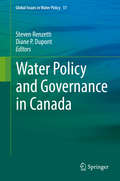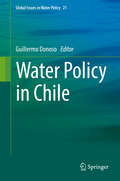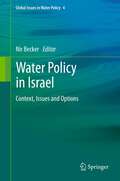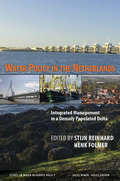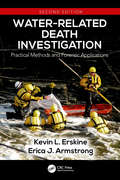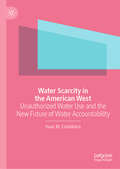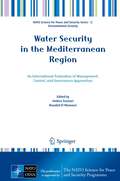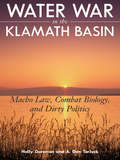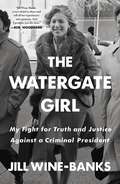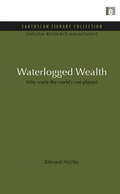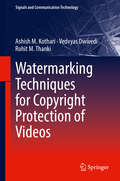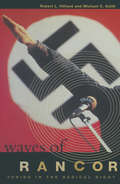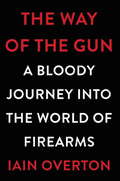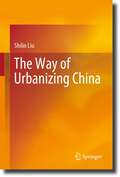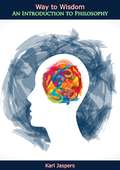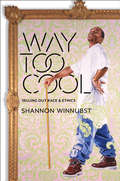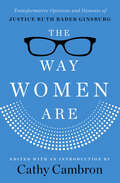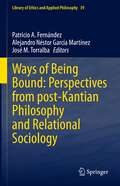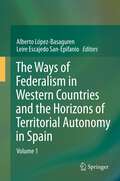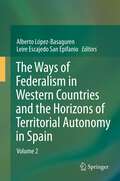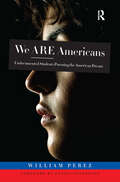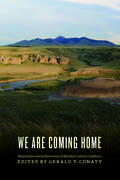- Table View
- List View
Water Policy and Governance in Canada
by Steven Renzetti Diane P. DupontThis book provides an insightful and critical assessment of the state of Canadian water governance and policy. It adopts a multidisciplinary variety of perspectives and considers local, basin, provincial and national scales. Canada's leading authorities from the social sciences, life and natural sciences address pressing water issues in a non-technical language, making them accessible to a wide audience. Even though Canada is seen as a water-rich country, with 7% of the world's reliable flow of freshwater and many of the world's largest rivers, the country nevertheless faces a number of significant water-related challenges, stemming in part from supply-demand imbalances but also a range of water quality issues. Against the backdrop of a water policy landscape that has changed significantly in recent years, this book therefore seeks to examine water-related issues that are not only important for the future of Canadian water management but also provide insights into transboundary management, non-market valuation of water, decentralized governance methods, the growing importance of the role of First Nations peoples, and other topics in water management that are vital to many jurisdictions globally. The book also presents forward-looking approaches such as resilience theory and geomatics to shed light on emerging water issues. Researchers, students and those directly involved in the management of Canadian waters will find this book a valuable source of insight. In addition, this book will appeal to policy analysts, people concerned about Canadian water resources specifically as well as global water issues.
Water Policy in Chile (Global Issues in Water Policy #21)
by Guillermo DonosoThis book offers a detailed examination of the main sources of Chile’s water, its principle consumers, the gap between supply and demand, hydrological droughts, and future projected impacts of climate change. It describes, analyzes and evaluates the performance of water policies, laws and institutions, identifies the main challenges that Chile needs to face and derives lessons learnt from Chile’s reform experience.Expert contributors discuss such topics as Chile’s water policy, and the reasoning which explains its policy reform. The book presents and evaluates the performance of the legal and institutional framework of water resources. It also describes efforts to meet actual demands for water by augmenting supplies with groundwater management, waste water re-use and desalination and improve the state of water ecosystems. The last chapter presents the editor’s assessment and conclusions. The case of Chile is illustrative of a transition from command and control to market based management policies, where economic incentives play a significant role in water management.
Water Policy in Israel
by Nir BeckerThis book deals with water policy in Israel. It offers a detailed examination of the main sources of Israel's water, its principle consumers, the gap between supply and demand, and the complex, contentious work of analyzing and devising the nation's water management and use policies. Water Policy in Israel is arranged in five broad sections: The dynamics of moving from one policy era to another; Supply management; Demand management; The importance of the Sea of Galilee and the Dead Sea; and Regional and global issues including water conflict and cooperation and climate change.
Water Policy in the Netherlands: Integrated Management in a Densely Populated Delta
by Stijn Reinhard Henk FolmerAs a low-lying delta region with a high population density, the Netherlands has long focused on the prevention of flooding catastrophes and the reclamation of valuable land. The evolution of Dutch water governance, beginning with the creation of local 'water boards' in the Middle Ages and growing into a complex infrastructure of polders, dams, and controlled waterways offers a compelling study of pitfalls and successes within one of the worlds most challenging regions for water management. Water Policy in the Netherlands traces the arc of water governance in the country, from technological innovations to prevent wide-scale flooding, to strategies focused primarily on improving water quality, to an integral water management approach which brings together perspectives from economics, hydrology, ecology, water law, and water technology. The contributions in this book demonstrate how both the technical and social sciences must play key roles in crafting policy in the face of serious environmental challenges including climate change, sea level rise, and increasing soil subsidence. Innovative themes explored in the work include: how economic models and pricing structures might improve efficiency in the distribution of water resources, how the competing uses for water-including for recreation, arable agriculture, fisheries, and natural preservation-create demands on both the quantity and quality of water resources, and how public participation, cogovernance, and the balance of public and private interests will be necessary to meet the goals of the EU‘s Water Framework Directive. This resource serves as both an invaluable case study and as a text to develop the analytical tool of integral water management for students, policy-makers, and NGO professionals in developed and developing regions.
Water-Related Death Investigation: Practical Methods and Forensic Applications
by Kevin L. Erskine Erica J. ArmstrongNearly ten years after the first edition of Water-Related Death Investigation: Practical Methods and Forensic Applications, water death cases continue to be improperly investigated. The pathologist’s report can determine the cause of death as a drowning, but the manner of death is the most challenging to prove. The report will not determine if a victim jumped into the water to commit suicide, fell into the water accidentally, or was pushed in as a homicidal act. Many drowning cases do not reflect injury to the body, so evidence collected at the scene plays a vital role. The importance of an on-scene body assessment cannot be overemphasized. Often, the body evidence begins to change rapidly upon recovery and may not be present during an autopsy. Written statements on the scene are an effective tool to use to determine the accuracy of information given to arriving officers. These statements need to be written by the witnesses themselves as well as the reporting person. The "Show Me" technique can also help reveal discrepancies in a person’s version of what occurred as well as aid in providing the most details to an incident as is humanly possible. This second edition includes updated information on the latest technology to assist water death investigators. Parabon Snapshot can help determine the faceless identity of skeletal remains and help locate potential suspects using the science of DNA. Drones can aid in locating missing persons as well as human remains, even months after death. Updated information is provided regarding fingerprints from submerged objects, and Carbon-14 can help determine the origin of a found corpse. Key Features: Thoroughly reviews the physiological aspects of drowning Reveals the investigative characteristics inherent to various scenes of water-related deaths Highlights certain "red flag" indicators that may point to foul play or scene staging Outlines autopsy protocols, trial preparation, and expert witness testimony Provides numerous case studies and numerous illustrations to further clarify key points presented in the text Coauthored by a Master Water Death Investigator and an experienced forensic pathologist, Water-Related Death Investigation: Practical Methods and Forensic Applications, Second Edition merges the essentials of evidence collection and field investigation with autopsy best practices and laboratory testing. It will continue to serve as a valuable resource for the various professionals involved in these cases.
Water Scarcity in the American West: Unauthorized Water Use and the New Future of Water Accountability
by Isaac M. CastellanoThis book examines the role of unauthorized water use in the American West (Arizona, California, Colorado, Idaho, Montana, Nevada, New Mexico, Oregon, Utah, Washington, and Wyoming) and the coming demand for water accountability. Arguing that status quo responses to unauthorized water use (or water theft) and the protection of water rights are largely inadequate, this title examines the far-ranging impacts of this lackluster response on issues ranging from food production to urban livability, and concludes that there will be intense pressure at both the federal and state level to address these issues. Utilizing qualitative and quantitative models and collaborative management literature to identify ideal approaches, this project ultimately seeks to address this major crisis of states’ legitimacy and analyze potential solutions under the ever-expanding threat of climate change.
Water Security in the Mediterranean Region
by Andrea Scozzari Bouabid El MansouriThe role of water in our communities, from local to regional and right up to global levels, poses a series of key questions about climate change, about the anthropogenic impact on the environment, and about all the interconnected actions and events that affect the availability and quality of the resource. All these questions share a common demand for more scientific knowledge and information. In this particular context the disciplinary boundaries are fading, and there is a growing need to create broader connections and wider collaborative interdisciplinary groups, aimed at building an integrated knowledge-base to serve not only stakeholders but also the whole of society. Only in this way can we hope to respond effectively to the challenges and changing dynamics of human-hydrologic systems. Following this concept, contributors from multiple disciplinary backgrounds, such as Law Studies, Hydrogeology, Monitoring and Information Technologies, Geophysics, Geochemistry, Environmental Sciences, Systems Engineering, Economics and Social Studies, joined forces and interacted in this workshop. The present book reports the proceedings of this three-day ARW (Advanced Research Workshop), and explores different aspects of the environmental security assessment process, focusing on the assessment, monitoring and management of water resources, and giving an overview of the related scientific knowledge.
Water War in the Klamath Basin: Macho Law, Combat Biology, and Dirty Politics
by A. Dan Tarlock Holly D. DoremusIn the drought summer of 2001, a simmering conflict between agricultural and environmental interests in southern Oregon's Upper Klamath Basin turned into a guerrilla war of protests, vandalism, and apocalyptic rhetoric when the federal Bureau of Reclamation shut down the headgates of the Klamath Project to conserve water needed by endangered species. This was the first time in U.S. history that the headgates of a federal irrigation project were closed--and irrigators denied the use of their state water rights--in favor of conservation. Farmers mounted a brief rebellion to keep the water flowing, but ultimately conceded defeat. In Water War in the Klamath Basin, legal scholars Holly Doremus and A. Dan Tarlock examine the genesis of the crisis and its fallout, offering a comprehensive review of the event, the history leading up to it, and the lessons it holds for anyone seeking to understand conflicts over water use in the arid West. The authors focus primarily on the legal institutions that contributed to the conflict--what they call "the accretion of unintegrated resource management and environmental laws" that make environmental protection so challenging, especially in politically divided regions with a long-standing history of entitlement-based resource allocation. Water War in the Klamath Basin explores common elements fundamental to natural resource conflicts that must be overcome if conflicts are to be resolved. It is a fascinating look at a topic of importance for anyone concerned with the management, use, and conservation of increasingly limited natural resources.
The Watergate Girl: My Fight for Truth and Justice Against a Criminal President
by Jill Wine-BanksObstruction of justice, the specter of impeachment, sexism at work, shocking revelations: Jill Wine-Banks takes us inside her trial by fire as a Watergate prosecutor. It was a time, much like today, when Americans feared for the future of their democracy, and women stood up for equal treatment. At the crossroads of the Watergate scandal and the women’s movement was a young lawyer named Jill Wine Volner (as she was then known), barely thirty years old and the only woman on the team that prosecuted the highest-ranking White House officials. Called “the mini-skirted lawyer” by the press, she fought to receive the respect accorded her male counterparts—and prevailed.In The Watergate Girl, Jill Wine-Banks opens a window on this troubled time in American history. It is impossible to read about the crimes of Richard Nixon and the people around him without drawing parallels to today’s headlines. The book is also the story of a young woman who sought to make her professional mark while trapped in a failing marriage, buffeted by sexist preconceptions, and harboring secrets of her own. Her house was burgled, her phones were tapped, and even her office garbage was rifled through.At once a cautionary tale and an inspiration for those who believe in the power of justice and the rule of law, The Watergate Girl is a revelation about our country, our politics, and who we are as a society.
Waterlogged Wealth: Why waste the world's wet places? (Natural Resource Management Set)
by Edward MaltbyDon't drain the swamp! Man's traditional response to swamps, marshes and bogs has been to drain them. But wetlands are not wastelands. Coastal marshes are among the world's most productive ecosystems. They make many commercial fisheries possible and protect coasts from floods and storm surges. Wetlands are pollution filters, water reservoirs. They are among the last wild places on earth, offering homes to endangered plants, birds and animals. Attitudes to wetlands are changing, but not fast enough. As scientists are documenting the wealth in wet places, governments and developers are draining them, damming them, logging them and building resort hotels where ', they once were. Destruction is usually a poor trade-off: well-managed wetlands in Louisiana are producing fortunes in seafood and timber. Waterlogged wealth examines the value of swamps and marshes, as well as the threats against them. In doing so it takes the reader to some of the world's most bizarre landscapes: the 'inland delta' of the Niger River in drought-stricken Mali; the wildlife-rich Okavango swamps of Botswana; the waterlogged Sunderban forests of India and Bangladesh, where tigers eat fish and crabs. Civilisation began around wetlands; today's civilisation has good reason to leave them wet and wild. Dr Edward Maltby is a lecturer in geography at the University of Exeter(UK). He has done extensive research on wetlands both in the North (UK, US, Canada) and the South (Fiji, Jamaica, India and the Falklands/Malvinas Islands). He is on the IUCN Wetland Programme Advisory Committee. Originally published in 1986
Watermarking Techniques for Copyright Protection of Videos (Signals and Communication Technology)
by Ashish M. Kothari Vedvyas Dwivedi Rohit M. ThankiThe book provides copyright protection approaches for videos using watermarking. The various watermarking techniques using various transforms such as discrete cosine transform (DCT), discrete wavelet transform (DWT) and singular value decomposition (SVD) for videos are presented. The book also provides video watermarking approach using compressive sensing (CS) theory. The presented watermarking techniques are designed and implemented using color digital videos. The performance of the presented techniques is evaluated using Peak Signal to Noise Ratio (PSNR) and Normalized Correlation (NC).
Waves of Rancor: Tuning into the Radical Right
by Robert L. Hilliard Michael C. KeithThe airwaves in America are being used by armed militias, conspiracy theorists, survivalists, the religious right, white supremacists, neo-Nazis, and other radical groups to reach millions with their messages of hate and fear. Waves of Rancor examines the origin, nature, and impact of right-wing electronic media, including radio, television, cable, the internet, and even music CDs.
The Way of the Gun: A Bloody Journey into the World of Firearms
by Iain OvertonA "riveting," "relentlessly engrossing," and "brilliantly researched" investigation of the life of the gun -- its manufacture, its sale, and its impact -- and of our world's hugely complex relationship with firearms.In some places of the world, getting a gun is easier than getting a glass of water. In some parts of the world, an individual is allowed to carry concealed firearms into schools. In some parts of the world, there are more guns than people to shoot them. There are almost 1 billion guns across the globe today, a shocking number that is higher than ever before in history. Each year, 12 billion bullets are produced -- almost two bullets for every person on the planet. And over 300,000 people are shot dead over an average year worldwide. In The Way of the Gun award-winning investigative journalist Iain Overton takes readers on a shocking and eye-opening journey to over 25 cities all across the globe, from Cape Town to Tokyo, from San Pedro Sula to Phnom Penh, along the way encountering people from all walks of life affected by guns: Zionist anti-terror gun trainers; El Salvadoran gangland killers; porn starlets who appear as snipers in triple-X films; and South African doctors soaked in the blood of gunshot victims -- unearthing some hard truths about the terrible realities of war and gun crime. Harrowing and sobering, this riveting expose on the long-reaching and mostly unknown life of a gun is an essential and important book in today's world.From the Hardcover edition.
The Way of Urbanizing China
by Shilin LiuThe book conducts a comprehensive research study on China’s urbanization. It puts forward three theoretical development models of urban planning in China, i.e., the politics-oriented city, the economy-oriented city and the human-oriented cultural city. It makes objective evaluations of the development models of the politics-oriented city and the economy-oriented city. It suggests that relations between the government and the market should be straightened out to solve the hangovers of the development model of the politics-oriented city, and eco-civilization development and cultural development should be put on the top of the government’s agenda in order to cope with the recurring problems and complications brought about by the development model of the economy-oriented city.
The Way Out of Obamacare
by Sally C. PipesPresident Barack Obama has declared that his signature health reform law - the Patient Protection and Affordable Care Act - is "here to stay. " But his days in the White House are numbered, and the law has failed: insurance premiums and deductibles have skyrocketed, patients are losing access to doctors, and economic growth has been crushed. In this Broadside, Sally C. Pipes provides an actionable blueprint for health care reform this campaign season, which the next president can implement on Day One. This book provides a replacement plan for Obamacare - one that will provide affordable, accessible, quality health care for all Americans.
Way to Wisdom: An Introduction to Philosophy (Nota Bene Ser.)
by Karl JaspersOne of the founders of existentialism, the eminent philosopher Karl Jaspers here presents for the general reader an introduction to philosophy. In doing so, he also offers a lucid summary of his own philosophical thought. In Jaspers' view, the source of philosophy is to be found "in wonder, in doubt, in a sense of forsakenness," and the philosophical quest is a process of continual change and self-discovery.—Print ed.
Way Too Cool
by Shannon WinnubstLife, liberty, and the pursuit of cool have informed the American ethos since at least the 1970s. Whether we strive for it in politics or fashion, cool is big business for those who can sell it across a range of markets and media. Yet the concept wasn't always a popular commodity. Cool began as a potent aesthetic of post-World War II black culture, embodying a very specific, highly charged method of resistance to white supremacy and the globalized exploitation of capital. Way Too Cool follows the hollowing-out of "coolness" in modern American culture and its reflection of a larger evasion of race, racism, and ethics now common in neoliberal society. It revisits such watershed events as the 1960s Civil Rights Movement, second-wave feminism, the emergence of identity politics, 1980s multiculturalism, 1990s rhetorics of diversity and colorblindness, 9/11, and Hurricane Katrina, as well as the contemporaneous developments of rising mass incarceration and legalized same-sex marriage, to pair the perversion of cool with the slow erasure of racial and ethical issues from our social consciousness, which effectively quashes our desire to act ethically and resist abuses of power. The cooler we become, the more indifferent we grow to the question of values, particularly inquiry that spurs protest and conflict. This book sounds an alarm for those who care about preserving our ties to an American tradition of resistance.
Way Too Cool: Selling Out Race and Ethics
by Shannon WinnubstLife, liberty, and the pursuit of cool have informed the American ethos since at least the 1970s. Whether we strive for it in politics or fashion, cool is big business for those who can sell it across a range of markets and media. Yet the concept wasn't always a popular commodity. Cool began as a potent aesthetic of post-World War II black culture, embodying a very specific, highly charged method of resistance to white supremacy and the globalized exploitation of capital.Way Too Cool follows the hollowing-out of "coolness" in modern American culture and its reflection of a larger evasion of race, racism, and ethics now common in neoliberal society. It revisits such watershed events as the 1960s Civil Rights Movement, second-wave feminism, the emergence of identity politics, 1980s multiculturalism, 1990s rhetorics of diversity and colorblindness, 9/11, and Hurricane Katrina, as well as the contemporaneous developments of rising mass incarceration and legalized same-sex marriage. It pairs the perversion of cool with the slow erasure of racial and ethical issues from our social consciousness, which effectively quashes our desire to act ethically and resist abuses of power. The cooler we become, the more indifferent we grow to the question of values, particularly inquiry that spurs protest and conflict. This book sounds an alarm for those who care about preserving our ties to an American tradition of resistance.
The Way Women Are: Transformative Opinions and Dissents of Justice Ruth Bader Ginsburg
by Cathy CambronA collection of US Justice Ruth Bader Ginsburg&’s legal writings spanning her career, featuring her arguments, opinions, and dissents. US Supreme Court Justice Ruth Bader Ginsburg spent her life defying notions about women. She garnered the status of a cultural icon, the &“Notorious RBG.&” Her life story is inspirational, and her work ethic is aspirational. Ginsburg&’s dissents on behalf of liberal values have been lauded. She has been the subject of films and books, and her image has even been featured on everything from T-shirts to scented candles. But what is known about how her viewpoint shaped the development of law in the United States from the 1970s to 2020? The Way Women Are collects a broad range of Justice Ginsburg&’s legal writings, shedding light on who she was and what she contributed to American jurisprudence. The book begins with her arguments before the Supreme Court as a women&’s rights advocate in the 1970s. It proceeds to her opinions and dissents as a member of the Court. The opinions range from United States v. Virginia (1996) to Little Sisters of the Poor (2020)—a case she participated in from her hospital bed. Also included are a brief biography of Ginsburg and introductions to the writings that explain the background, issues, and laws involved in each case. Additionally, the collection includes oral arguments and bench announcements of decisions to make the issues more accessible. Altogether, The Way Women Are sketches an enlightening portrait of an extremely influential American jurist.
Ways of Being Bound: Perspectives from post-Kantian Philosophy and Relational Sociology (Library of Ethics and Applied Philosophy #39)
by Patricio A. Fernández Alejandro Néstor García Martínez José M. TorralbaThis book addresses the topic of 'being bound' from a philosophical and a sociological perspective. It examines several ways in which we are bound. We are bound to acknowledge the truth and to follow laws; we are bound to others and to the world. Who we are is partly defined by those bonds, regardless of whether we live up to them – or even of whether we acknowledge them. Puzzling questions arise from the fact that we are bound, such as: How are those bonds binding? Wherein lies their normative character? A venerable philosophical tradition, particularly since Kant, has provided an account of normativity that crucially appeals to such notions as “self-legislation.” But can our normative bonds be properly understood in these essentially first-personal terms? Many argue that our social condition resists any account of those bonds that fails to acknowledge the perspectives of the second and the third person. The first part of the book explores these themes from a historical perspective in the tradition of transcendental philosophy (Kant, Fichte, Hegel, Husserl and Heidegger); it examines the phenomenon of “being bound”, i.e., why and how we are bound. The second part of the book offers a sociological analysis of social bonds that is both historical and systematic. Based on sociological approaches to “solidarity” and “reflexivity”, it explores the way in which the phenomenon of “being bound” manifests through the concept of a “social relation”.
The Ways of Federalism in Western Countries and the Horizons of Territorial Autonomy in Spain, Volume 1
by Alberto López Basaguren Leire Escajedo San EpifanioTerritorial autonomy in Spain has reached a crossroads. After over thirty years of development, the consensus regarding its appropriateness has started to crumble. The transformation project embodied by the reform of Statute of Catalonia (2006) has failed to achieve its most significant demands. Although the concept of Spain as a Federation is disputed -more within the country than beyond-, the evolution of the Spanish system needs to follow a markedly federalist path. In this perspective, reference models assume critical importance. This edition gathers the works of a broad group of European, American and Spanish experts who analyse the present-day challenges of their respective systems. The objective, thus, is to contribute ideas which might help to address the evolution of the Spanish system in the light of the experience of more established Federations. This first volume analyses the challenges facing federal systems in the age of globalisation from a global perspective. It also addresses current questions and the challenges faced today by, in the sphere of the internal division of powers, the most significant ‘western’ federal systems, on the one hand, and the Spanish system of territorial autonomy, on the other.
The Ways of Federalism in Western Countries and the Horizons of Territorial Autonomy in Spain, Volume 2
by Alberto López Basaguren Leire Escajedo San EpifanioTerritorial autonomy in Spain has reached a crossroads. After over thirty years of development, the consensus regarding its appropriateness has started to crumble. The transformation project embodied by the reform of Statute of Catalonia (2006) has failed to achieve its most significant demands. Although the concept of Spain as a Federation is disputed -more within the country than beyond-, the evolution of the Spanish system needs to follow a markedly federalist path. In this perspective, reference models assume critical importance. This edition gathers the works of a broad group of European, American and Spanish experts who analyse the present-day challenges of their respective systems. The objective, thus, is to contribute ideas which might help to address the evolution of the Spanish system in the light of the experience of more established Federations. This second volume focuses its attention on the difficulties and challenges faced in two particular fields. On the one hand, the field of intergovernmental relations and, on the other, questions related to the integration and acknowledgement of diversity and of Fundamental Rights, with special reference to the cases of Canada and Spain. Finally, there is analysis of other specific aspects of the system of territorial autonomy in Spain.
Ways of Regulating Drugs in the 19th and 20th Centuries
by Jean-Paul Gaudillière Volker HessThis collection takes the perspective that the historiography of science, technology, and medicine needs a broader approach toward regulation. The authors explore the distinct social worlds involved in regulation, the forms of evidence and expertise mobilized, and means of intervention chosen to tame drugs in factories, consulting rooms and courts.
We ARE Americans: Undocumented Students Pursuing the American Dream
by William PerezWinner of the CEP Mildred Garcia Award for Exemplary ScholarshipAbout 2.4 million children and young adults under 24 years of age are undocumented. Brought by their parents to the US as minors—many before they had reached their teens—they account for about one-sixth of the total undocumented population. Illegal through no fault of their own, some 65,000 undocumented students graduate from the nation's high schools each year. They cannot get a legal job, and face enormous barriers trying to enter college to better themselves—and yet America is the only country they know and, for many, English is the only language they speak. What future do they have? Why are we not capitalizing, as a nation, on this pool of talent that has so much to contribute? What should we be doing?Through the inspiring stories of 16 students—from seniors in high school to graduate students—William Perez gives voice to the estimated 2.4 million undocumented students in the United States, and draws attention to their plight. These stories reveal how—despite financial hardship, the unpredictability of living with the daily threat of deportation, restrictions of all sorts, and often in the face of discrimination by their teachers—so many are not just persisting in the American educational system, but achieving academically, and moreover often participating in service to their local communities. Perez reveals what drives these young people, and the visions they have for contributing to the country they call home.Through these stories, this book draws attention to these students’ predicament, to stimulate the debate about putting right a wrong not of their making, and to motivate more people to call for legislation, like the stalled Dream Act, that would offer undocumented students who participate in the economy and civil life a path to citizenship. Perez goes beyond this to discuss the social and policy issues of immigration reform. He dispels myths about illegal immigrants’ supposed drain on state and federal resources, providing authoritative evidence to the contrary. He cogently makes the case—on economic, social, and constitutional and moral grounds—for more flexible policies towards undocumented immigrants. If today’s immigrants, like those of past generations, are a positive force for our society, how much truer is that where undocumented students are concerned?
We Are Coming Home: Repatriation and the Restoration of Blackfoot Cultural Confidence
by Allan Pard Chris Mchugh Frank Weasel Head Gerald T. Conaty Herman Yellow Old Woman Jerry Potts John W. Ives Robert R. JanesIn 1990, Gerald Conaty was hired as senior curator of ethnology at the Glenbow Museum, with the particular mandate of improving the museum’s relationship with Aboriginal communities. That same year, the Glenbow had taken its first tentative steps toward repatriation by returning sacred objects to First Nations’ peoples. These efforts drew harsh criticism from members of the provincial government. Was it not the museum’s primary legal, ethical, and fiduciary responsibility to ensure the physical preservation of its collections? Would the return of a sacred bundle to ceremonial use not alter and diminish its historical worth and its value to the larger society? Undaunted by such criticism, Conaty oversaw the return of more than fifty medicine bundles to Blackfoot and Cree communities between the years of 1990 and 2000, at which time the First Nations Sacred Ceremonial Objects Repatriation Act (FNSCORA)—still the only repatriation legislation in Canada—was passed. “Repatriation,” he wrote, “is a vital component in the creation of an equitable, diverse, and respectful society.” We Are Coming Home is the story of the highly complex process of repatriation as described by those intimately involved in the work, notably the Piikuni, Siksika, and Kainai elders who provided essential oversight and guidance. We also hear from the Glenbow Museum’s president and CEO at the time and from an archaeologist then employed at the Provincial Museum of Alberta who provides an insider’s view of the drafting of FNSCORA. These accounts are framed by Conaty’s reflections on the impact of museums on First Nations, on the history and culture of the Niitsitapi, or Blackfoot, and on the path forward. With Conaty’s passing in August of 2013, this book is also a tribute to his enduring relationships with the Blackfoot, to his rich and exemplary career, and to his commitment to innovation and mindful museum practice.
